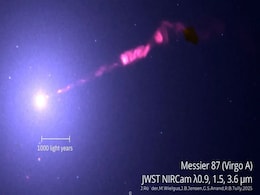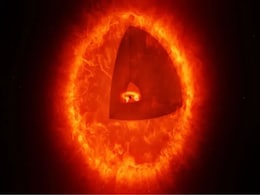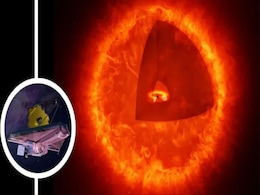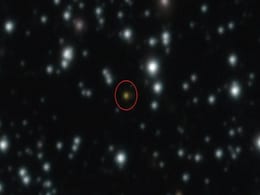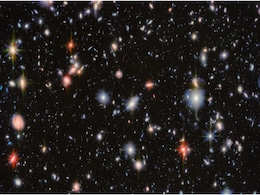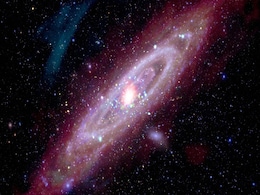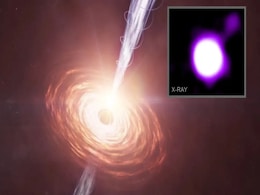Nasa Black Hole
- All
- News
-

Astronomers Capture First Image of Two Supermassive Black Holes Orbiting Each Other
- Tuesday October 14, 2025
- Written by Gadgets 360 Staff
Astronomers have captured the first image of two supermassive black holes orbiting in quasar OJ 287. The smaller black hole’s jet spirals due to gravitational forces from the larger one. This discovery validates dual-core theories and opens doors for research on gravitational waves and galaxy evolution.
-
 www.gadgets360.com
www.gadgets360.com
-

JWST Reveals Stunning New Details About M87’s Supermassive Black Hole Jet
- Saturday October 4, 2025
- Written by Gadgets 360 Staff
Recent images captured by the James Webb Space Telescope (JWST) are the clearest ever pictures of the jet arriving from the massive black hole in the galaxy named Messier 87 (M87). There are clear details in the image shot by the telescope, which show the change of brightness, shape and the jet that is usually in disguise. As per scientists, this d...
-
 www.gadgets360.com
www.gadgets360.com
-

NASA’s James Webb Telescope May Have Found First Black Hole Star, Known as ‘The Cliff’
- Thursday September 25, 2025
- Written by Gadgets 360 Staff
JWST detected “The Cliff,” a candidate black hole star with a black hole core wrapped in a luminous gas shell. This discovery offers insights into black hole formation, stellar evolution, and cosmic dynamics, prompting astronomers to search for similar objects across the universe.
-
 www.gadgets360.com
www.gadgets360.com
-

NASA’s Chandra Finds Black Hole Growing Beyond Known Limits
- Sunday September 28, 2025
- Written by Gadgets 360 Staff
A black hole in quasar RACS J0320-35, 12.8 billion light-years away, is growing 2.4 times faster than theory permits. Chandra’s discovery challenges ideas of how supermassive black holes formed so soon after the Big Bang.
-
 www.gadgets360.com
www.gadgets360.com
-

Tiny Red Dots Spotted By NASA’s James Webb Telescope Could Be Black Hole Stars
- Thursday September 25, 2025
- Written by Gadgets 360 Staff
NASA’s James Webb Space Telescope revealed mysterious “little red dots” that seem too bright and mature for their age. A new study suggests they may be black hole stars—giant hydrogen spheres powered by black holes—helping explain the rapid growth of early supermassive black holes.
-
 www.gadgets360.com
www.gadgets360.com
-

NASA Detects Strange Gamma-Ray Burst That Defies 50 Years of Expectations
- Thursday September 11, 2025
- Written by Gadgets 360 Staff
Astronomers have spotted GRB 250702B, a gamma-ray burst that erupted several times over two days—something never seen before. Detected by NASA’s Fermi and China’s Einstein Probe, the event defies current models of collapsing stars or black holes, hinting at an entirely new cosmic phenomenon.
-
 www.gadgets360.com
www.gadgets360.com
-

This Massive Black Hole May Have Formed In Early Big Bang Era
- Wednesday September 3, 2025
- Science | Edited by NDTV News Desk
Until now, scientists thought stars and galaxies formed first, and black holes appeared later after the earliest stars ran out of fuel and collapsed.
-
 www.ndtv.com
www.ndtv.com
-

NASA’s IXPE Challenges Theories on Black Hole Corona and Polarised X-Ray Emissions
- Saturday August 16, 2025
- Written by Gadgets 360 Staff
NASA’s Imaging X-ray Polarimetry Explorer (IXPE) has made surprising observations in a black hole binary system, detecting a high degree of X-ray polarisation that challenges current models of corona structure and accretion discs. In X-ray binaries, black holes pull matter from nearby stars, forming hot accretion discs and coronas.
-
 www.gadgets360.com
www.gadgets360.com
-

James Webb Space Telescope Reimagines Hubble’s Deep Field, Unveils Ancient Galaxies
- Tuesday August 5, 2025
- Written by Gadgets 360 Staff
The James Webb Space Telescope has re-imaged part of Hubble’s Ultra Deep Field, revealing over 2,500 galaxies in stunning infrared detail. Using its NIRCam and MIRI instruments, Webb observed faint galaxies dating back to just a few hundred million years after the Big Bang. This is part of the JADES survey, which includes the deepest mid-infrared...
-
 www.gadgets360.com
www.gadgets360.com
-

Brightest Gamma-Ray Burst Ever Observed Reveals Cosmic Secrets
- Friday August 1, 2025
- Written by Gadgets 360 Staff
On October 9, 2022, astronomers detected GRB 221009A, the most powerful gamma-ray burst ever recorded, earning the nickname “BOAT” (Brightest Of All Time). This rare, once-in-10,000-year event came from a galaxy 2 billion light-years away and temporarily blinded gamma-ray detectors. It revealed new insights into stellar death, as the associated...
-
 www.gadgets360.com
www.gadgets360.com
-

How The Largest Black Hole Merger In History Challenges Its Physics
- Thursday July 17, 2025
- Science | Edited by NDTV News Desk
Astronomers have detected the largest black hole merger ever, and it has challenged their understanding of such formations.
-
 www.ndtv.com
www.ndtv.com
-

James Webb Telescope Spots Rare ‘Cosmic Owl’ Formed by Colliding Galaxies
- Monday July 14, 2025
- Written by Gadgets 360 Staff
NASA’s James Webb Space Telescope has unveiled the “Cosmic Owl,” a jaw-dropping image of two colliding ring galaxies forming a structure that resembles an owl’s face. This double-ring formation is extraordinarily rare, and the event is shedding light on galaxy evolution, black hole dynamics, and rapid star formation. Led by Ph.D. student Mi...
-
 www.gadgets360.com
www.gadgets360.com
-

NASA’s Chandra Reveals Stunning Multi-Wavelength Image of Andromeda Galaxy
- Monday June 30, 2025
- Written by Gadgets 360 Staff
NASA’s Chandra X-ray Observatory has released a stunning composite image of the Andromeda galaxy, combining data across the electromagnetic spectrum. This multi-wavelength view highlights X-ray flares near the central black hole and pays tribute to Dr. Vera Rubin’s pioneering dark matter research. The image, also presented through a musical son...
-
 www.gadgets360.com
www.gadgets360.com
-

NASA Chandra Spots Distant X-Ray Jet; Telescope Faces Major Budget Cuts
- Sunday June 15, 2025
- Written by Gadgets 360 Staff
NASA’s Chandra X-ray Observatory has detected a massive X-ray jet from quasar J1610+1811, 11.6 billion light-years away. The jet travels at nearly the speed of light, illuminating black hole behavior during the universe’s early era. However, Chandra now faces potential defunding under NASA’s proposed budget. Astronomers warn that cutting Chan...
-
 www.gadgets360.com
www.gadgets360.com
-

NASA’s Chandra Spots Unexpectedly Strong Jet from Distant Black Hole at Cosmic Noon
- Wednesday June 11, 2025
- Written by Gadgets 360 Staff
NASA’s Chandra telescope has spotted two powerful black hole jets from over 11.6 billion light-years away. Detected during the universe’s cosmic noon, these jets reveal rare high-speed behaviour boosted by Big Bang remnants. The findings, which factor in relativistic effects, shed new light on early black hole growth and will be published in Th...
-
 www.gadgets360.com
www.gadgets360.com
-

Astronomers Capture First Image of Two Supermassive Black Holes Orbiting Each Other
- Tuesday October 14, 2025
- Written by Gadgets 360 Staff
Astronomers have captured the first image of two supermassive black holes orbiting in quasar OJ 287. The smaller black hole’s jet spirals due to gravitational forces from the larger one. This discovery validates dual-core theories and opens doors for research on gravitational waves and galaxy evolution.
-
 www.gadgets360.com
www.gadgets360.com
-

JWST Reveals Stunning New Details About M87’s Supermassive Black Hole Jet
- Saturday October 4, 2025
- Written by Gadgets 360 Staff
Recent images captured by the James Webb Space Telescope (JWST) are the clearest ever pictures of the jet arriving from the massive black hole in the galaxy named Messier 87 (M87). There are clear details in the image shot by the telescope, which show the change of brightness, shape and the jet that is usually in disguise. As per scientists, this d...
-
 www.gadgets360.com
www.gadgets360.com
-

NASA’s James Webb Telescope May Have Found First Black Hole Star, Known as ‘The Cliff’
- Thursday September 25, 2025
- Written by Gadgets 360 Staff
JWST detected “The Cliff,” a candidate black hole star with a black hole core wrapped in a luminous gas shell. This discovery offers insights into black hole formation, stellar evolution, and cosmic dynamics, prompting astronomers to search for similar objects across the universe.
-
 www.gadgets360.com
www.gadgets360.com
-

NASA’s Chandra Finds Black Hole Growing Beyond Known Limits
- Sunday September 28, 2025
- Written by Gadgets 360 Staff
A black hole in quasar RACS J0320-35, 12.8 billion light-years away, is growing 2.4 times faster than theory permits. Chandra’s discovery challenges ideas of how supermassive black holes formed so soon after the Big Bang.
-
 www.gadgets360.com
www.gadgets360.com
-

Tiny Red Dots Spotted By NASA’s James Webb Telescope Could Be Black Hole Stars
- Thursday September 25, 2025
- Written by Gadgets 360 Staff
NASA’s James Webb Space Telescope revealed mysterious “little red dots” that seem too bright and mature for their age. A new study suggests they may be black hole stars—giant hydrogen spheres powered by black holes—helping explain the rapid growth of early supermassive black holes.
-
 www.gadgets360.com
www.gadgets360.com
-

NASA Detects Strange Gamma-Ray Burst That Defies 50 Years of Expectations
- Thursday September 11, 2025
- Written by Gadgets 360 Staff
Astronomers have spotted GRB 250702B, a gamma-ray burst that erupted several times over two days—something never seen before. Detected by NASA’s Fermi and China’s Einstein Probe, the event defies current models of collapsing stars or black holes, hinting at an entirely new cosmic phenomenon.
-
 www.gadgets360.com
www.gadgets360.com
-

This Massive Black Hole May Have Formed In Early Big Bang Era
- Wednesday September 3, 2025
- Science | Edited by NDTV News Desk
Until now, scientists thought stars and galaxies formed first, and black holes appeared later after the earliest stars ran out of fuel and collapsed.
-
 www.ndtv.com
www.ndtv.com
-

NASA’s IXPE Challenges Theories on Black Hole Corona and Polarised X-Ray Emissions
- Saturday August 16, 2025
- Written by Gadgets 360 Staff
NASA’s Imaging X-ray Polarimetry Explorer (IXPE) has made surprising observations in a black hole binary system, detecting a high degree of X-ray polarisation that challenges current models of corona structure and accretion discs. In X-ray binaries, black holes pull matter from nearby stars, forming hot accretion discs and coronas.
-
 www.gadgets360.com
www.gadgets360.com
-

James Webb Space Telescope Reimagines Hubble’s Deep Field, Unveils Ancient Galaxies
- Tuesday August 5, 2025
- Written by Gadgets 360 Staff
The James Webb Space Telescope has re-imaged part of Hubble’s Ultra Deep Field, revealing over 2,500 galaxies in stunning infrared detail. Using its NIRCam and MIRI instruments, Webb observed faint galaxies dating back to just a few hundred million years after the Big Bang. This is part of the JADES survey, which includes the deepest mid-infrared...
-
 www.gadgets360.com
www.gadgets360.com
-

Brightest Gamma-Ray Burst Ever Observed Reveals Cosmic Secrets
- Friday August 1, 2025
- Written by Gadgets 360 Staff
On October 9, 2022, astronomers detected GRB 221009A, the most powerful gamma-ray burst ever recorded, earning the nickname “BOAT” (Brightest Of All Time). This rare, once-in-10,000-year event came from a galaxy 2 billion light-years away and temporarily blinded gamma-ray detectors. It revealed new insights into stellar death, as the associated...
-
 www.gadgets360.com
www.gadgets360.com
-

How The Largest Black Hole Merger In History Challenges Its Physics
- Thursday July 17, 2025
- Science | Edited by NDTV News Desk
Astronomers have detected the largest black hole merger ever, and it has challenged their understanding of such formations.
-
 www.ndtv.com
www.ndtv.com
-

James Webb Telescope Spots Rare ‘Cosmic Owl’ Formed by Colliding Galaxies
- Monday July 14, 2025
- Written by Gadgets 360 Staff
NASA’s James Webb Space Telescope has unveiled the “Cosmic Owl,” a jaw-dropping image of two colliding ring galaxies forming a structure that resembles an owl’s face. This double-ring formation is extraordinarily rare, and the event is shedding light on galaxy evolution, black hole dynamics, and rapid star formation. Led by Ph.D. student Mi...
-
 www.gadgets360.com
www.gadgets360.com
-

NASA’s Chandra Reveals Stunning Multi-Wavelength Image of Andromeda Galaxy
- Monday June 30, 2025
- Written by Gadgets 360 Staff
NASA’s Chandra X-ray Observatory has released a stunning composite image of the Andromeda galaxy, combining data across the electromagnetic spectrum. This multi-wavelength view highlights X-ray flares near the central black hole and pays tribute to Dr. Vera Rubin’s pioneering dark matter research. The image, also presented through a musical son...
-
 www.gadgets360.com
www.gadgets360.com
-

NASA Chandra Spots Distant X-Ray Jet; Telescope Faces Major Budget Cuts
- Sunday June 15, 2025
- Written by Gadgets 360 Staff
NASA’s Chandra X-ray Observatory has detected a massive X-ray jet from quasar J1610+1811, 11.6 billion light-years away. The jet travels at nearly the speed of light, illuminating black hole behavior during the universe’s early era. However, Chandra now faces potential defunding under NASA’s proposed budget. Astronomers warn that cutting Chan...
-
 www.gadgets360.com
www.gadgets360.com
-

NASA’s Chandra Spots Unexpectedly Strong Jet from Distant Black Hole at Cosmic Noon
- Wednesday June 11, 2025
- Written by Gadgets 360 Staff
NASA’s Chandra telescope has spotted two powerful black hole jets from over 11.6 billion light-years away. Detected during the universe’s cosmic noon, these jets reveal rare high-speed behaviour boosted by Big Bang remnants. The findings, which factor in relativistic effects, shed new light on early black hole growth and will be published in Th...
-
 www.gadgets360.com
www.gadgets360.com


